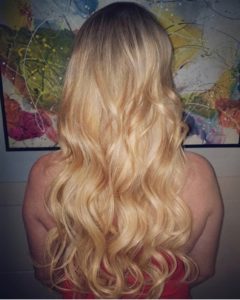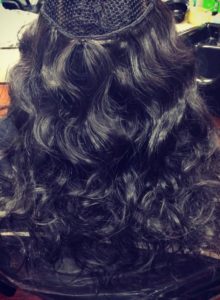12 Oct Things to Know: Hair Extensions
Many of us can go years without changing a thing. But sometimes we feel the overwhelming desire to switch it up, to keep it fresh, so the first place we look for change is our hair. However, we do not always want to make a permanent, drastic change. *Enter hair weave.* Hair weave allows us to experiment with our hair. We are able to see what it would look like longer, shorter, straighter, curlier, colored, etc., all while keeping our natural mane in tact. There are so many ways to install extensions, but two of the more common methods (Salon Brazyl’s recommended methods) are tape-ins and sew-ins. These two types of hair extensions cater differently to different situations and hair types. So, let us help you choose the right installation method for your hair.
Types of Hair Extensions
Tape-In Extensions
The tape-in method grew popular a few years back, and with good reason – it’s undetectable. There is a skin weft base (the tape) that is attached in an alternating pattern between layers of your natural hair. Because of the thin weft, the hair is able to lie flat thus allowing it to blend more easily with your hair. As your hair begins to grow, this type of hair extension grows out with it helping to maintain the natural look for longer. When it comes to removal, this style is one of the easiest, granted you have the right solvent.
Tape-in extensions installed at Salon Brazyl
Tape-ins are great for relaxed or naturally straight hair. It is also good for those with fine hair because it does not put excessive tension or stress on your hair. Women considering this style should know that it is not the best option for women with naturally curly hair, if only because your natural hair is still out, and it may not blend in a desirable way. While it is quicker to install extensions using the tape-in, it is much more tedious, thus making the price point for this style more steep. As far as brands go, Tish recommends Hotheads as it is the most popular brand for tape extensions, and a common training brand for stylists.
Sew-In Extensions
Perhaps the most well-known installation method for hair weave is the sew-in. This method involves braiding down your natural hair and attaching the weave to the braids. Some women choose to leave out part of their natural hair to help hide the foundation for the sew in and blend the hair better. Others choose to do a full sew in with a closure, which gives the allusion of a part at the front of the hair without having any exposed hair. Sew-ins are often referred to as a protective style since they give your hair a break from heat damage and allows it time to grow.
One major drawback of this method is the use of a needle. During installation, passing the needle through the braid can cause unnecessary ripping of the natural hair. It is for this reason that some stylists, Tish included, choose to use a net when installing a sew-in. This tactic involves braiding down the foundation and then sewing the net down to just the outer edge of the braids. While the needle still passes through the hair a little, it is far less intrusive than any other sew-in method.
Sew-in installation with a net at Salon Brazyl
Sew-ins go well with any hair type because your natural hair does not have to be out. You can choose any style regardless of what lies underneath. This versatility is what has made this hairstyle so popular among all women.
While both styles are intended for longer wear, and can last for at least two months, it is not recommended to wear them beyond that time frame. That type of extended wear can cause damage to your natural hair. For the best hair results, make sure to leave the installation process to the professionals, because we all know that there is nothing worse than a bad weave. Book with us today for a personal consultation to see which types of hair extensions are best for you, or for your own installation!





